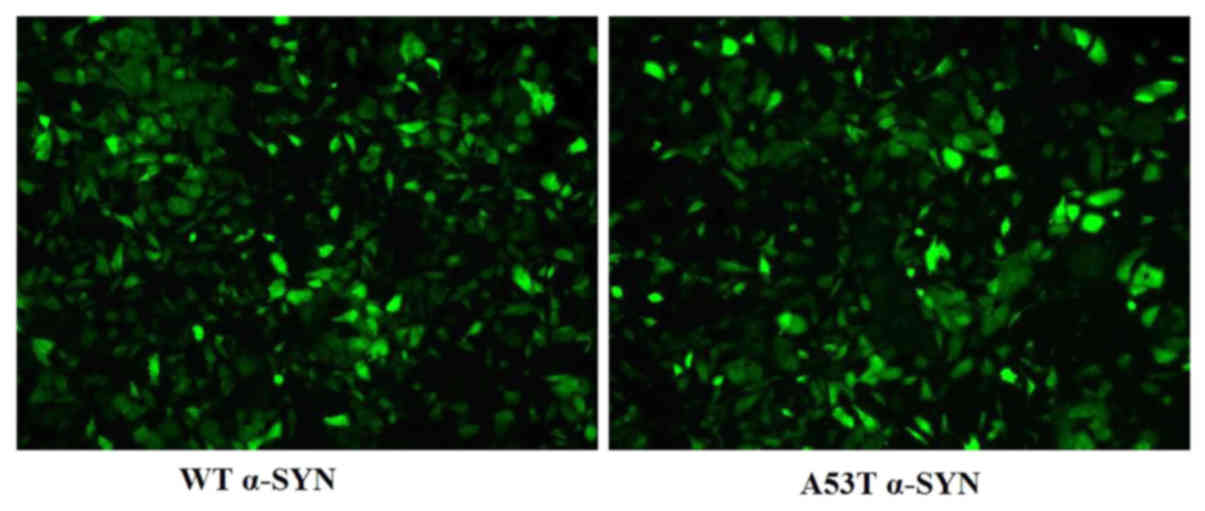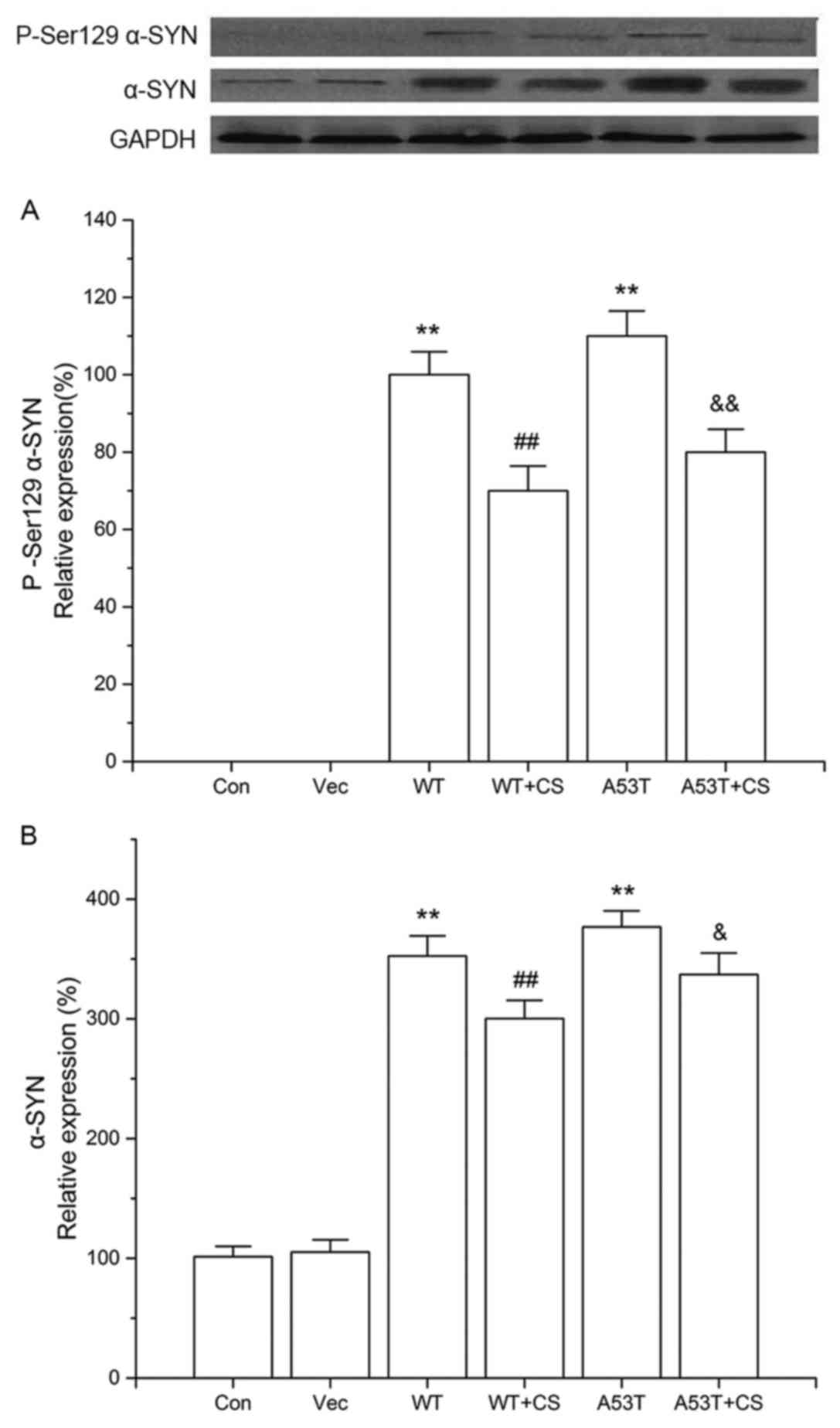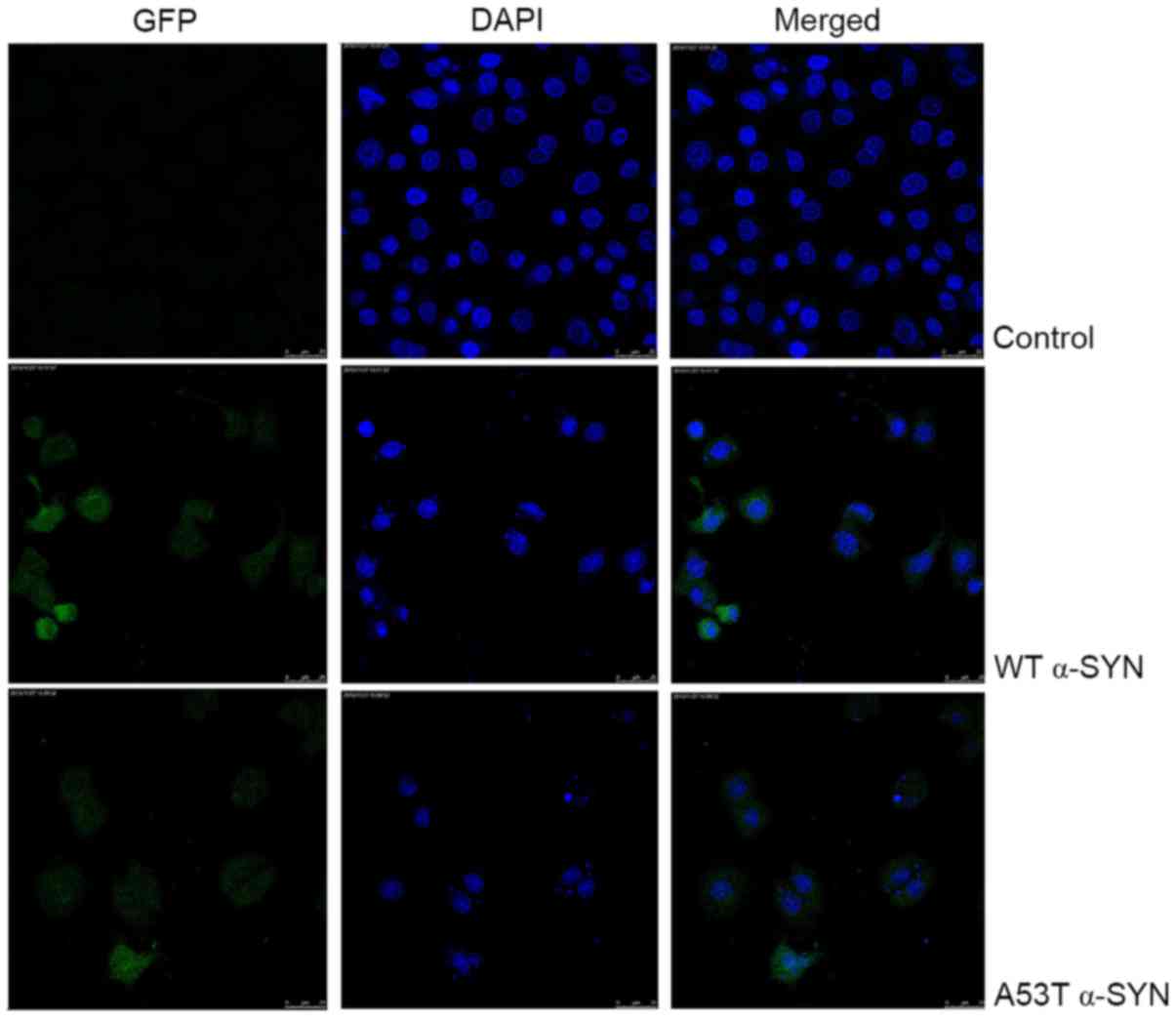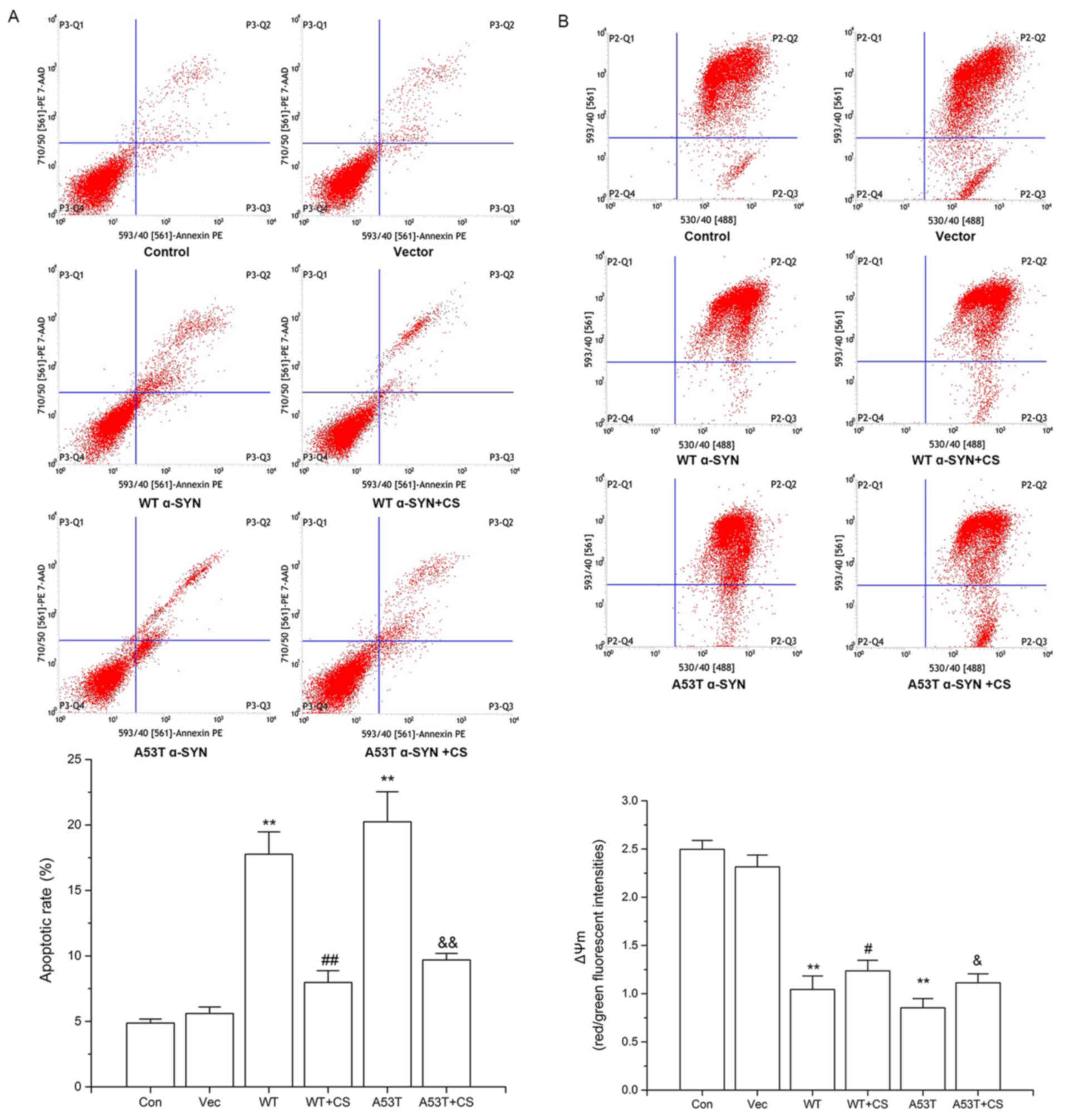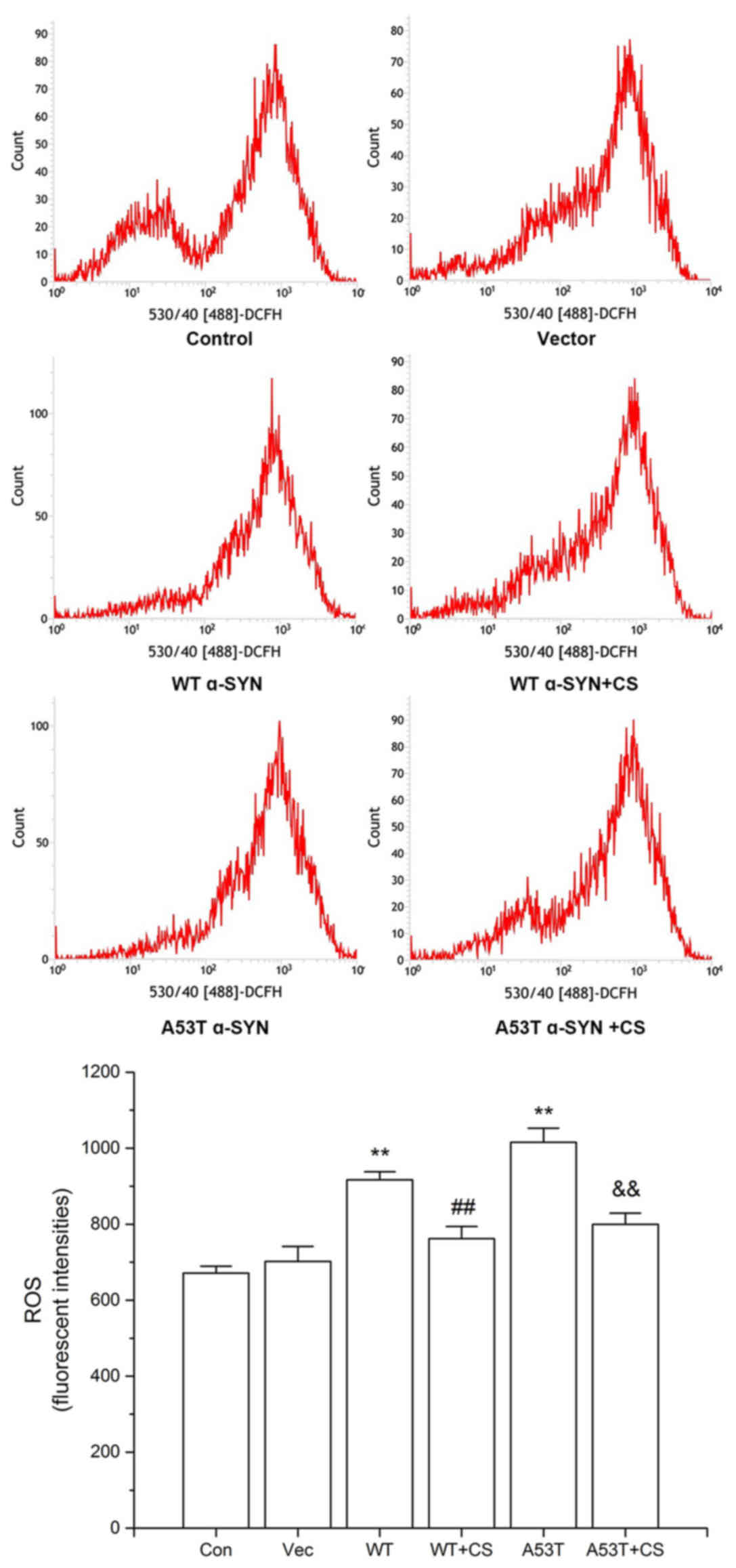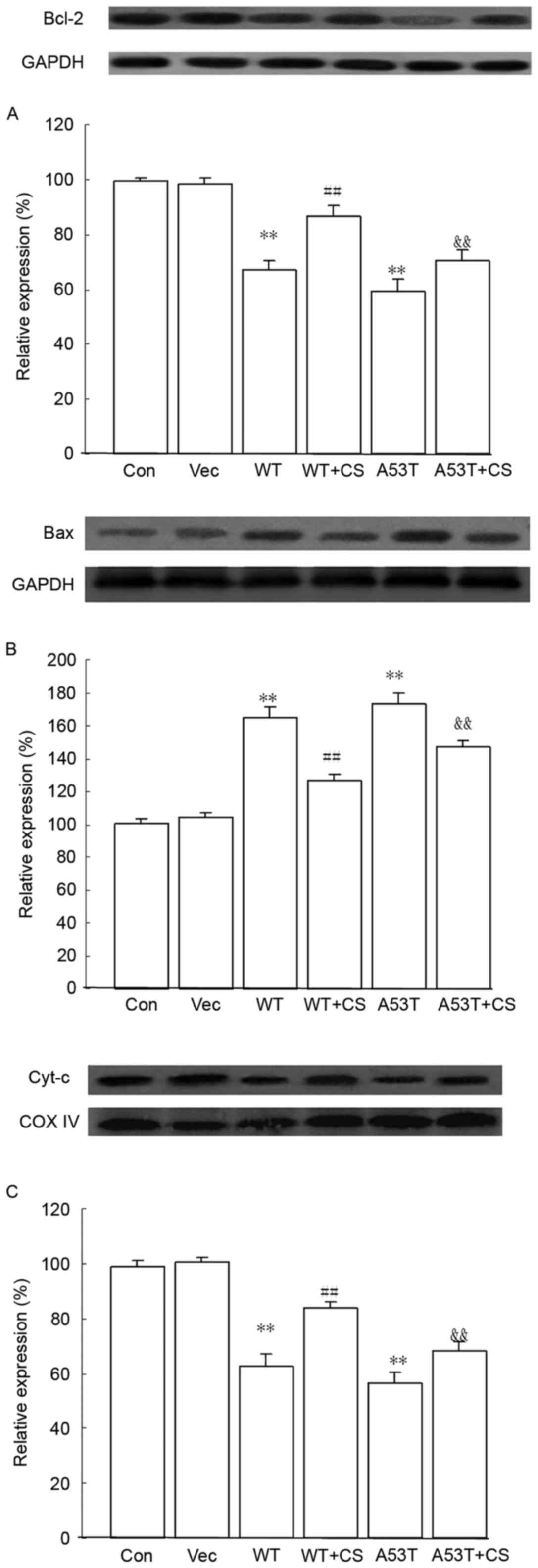Neuroprotective effect of chondroitin sulfate on SH‑SY5Y cells overexpressing wild‑type or A53T mutant α‑synuclein
- Authors:
- Published online on: October 4, 2017 https://doi.org/10.3892/mmr.2017.7725
- Pages: 8721-8728
-
Copyright: © Ju et al. This is an open access article distributed under the terms of Creative Commons Attribution License.
Abstract
Introduction
Parkinson's disease (PD) is a progressive neurodegenerative disorder characterized by the selective loss of midbrain dopaminergic neurons in the substantia nigra, and the development of Lewy bodies. α-synuclein (α-SYN) is a major component of the Lewy bodies, the misfolding and aggregation of which contribute to the pathogenesis of both familial and sporadic PD (1,2). Particularly, phosphorylated Ser129 α-SYN (P-Ser129 α-SYN) serves an important role in the formation of Lewy bodies and in the neurodegenerative process associated with PD. Inhibiting the formation and toxicity of the pathogenic proteins might be an applicable strategy.
Chondroitin sulfate (CS) is a natural glycosaminoglycan that is present in the extracellular matrix surrounding cells, which serves an important role in neural development and repair (3,4), promotes the survival of neuronal cells (5,6) and protects dopaminergic SH-SY5Y cells against 6-hydroxydopamine and hydrogen peroxide-induced toxicity (7,8). It also has been reported that CS inhibits β-amyloid' fibril formation, shortens the preformed amyloid fibrils (9) and attenuates β-amyloid-induced neurotoxicity in vitro and in vivo (10,11). Both β-amyloid and α-SYN are pathogenic proteins associated with neurodegenerative disorders. However, little is known about the effect of CS on the formation and toxicity of α-SYN.
Previous studies have demonstrated that PD can be caused by multiplications (duplication and triplication) of or mutations (A53T, E46K and A30P) in the α-SYN gene (12,13). Cells and animals overexpressing wild-type (WT) or mutant α-SYN are often used to study PD pathogenesis and therapeutic interventions (14,15). The aim of the present study was to investigate the protective effects of CS on α-SYN-induced damage in dopaminergic SH-SY5Y cells overexpressing WT or A53T mutant α-SYN.
Materials and methods
Cell culture
SH-SY5Y human neuroblastoma cells were purchased from the Typical Culture Preservation Commission Cell Bank, Chinese Academy of Sciences (Shanghai, China). All cells were maintained in minimum essential medium and Dulbecco's modified Eagle's medium/F12 (1:1; Gibco; Thermo Fisher Scientific, Inc., Waltham, MA, USA) supplemented with 10% heat-inactivated fetal bovine serum (Gibco; Thermo Fisher Scientific, Inc.) at 37°C in a tissue culture incubator with 5% CO2 and 98% relative humidity.
Stable transfection of SH-SY5Y cells
For stable transfection of SH-SY5Y cells, the LV5 expression vectors (Shanghai Gene Pharma Co., Ltd., Shanghai, China) containing a cytomegalovirus promoter were used. WT or A53T mutant α-SYN green fluorescent protein (GFP) fusion constructs were polymerase chain reaction-amplified using DNA Polymerase (Takara Bio, Inc., Otsu, Japan) and expression clones were created in the LV5 expression vectors. WT α-SYN cDNA insert was generated with primers AGG GTT CCA AGC TTA AGC GGC CGC G (forward) and GAT CCA TCC CTA GGT AGA TGC ATT TA (reverse) and the following PCR conditions: 94°C for 30 sec, 55°C for 30 sec, and 72°C for 30 sec, for 30 cycles. The complete A53T mutant α-SYN insert was generated through three steps. In the first step, A53T mutant α-SYN gene fragment I was generated with primers AGG GTT CCA AGC TTA AGC GGC CGC G (forward) and AAG CCA GTG GCT GTT GCA ATG CTC CCT GCT CCC TC (reverse) and the following PCR conditions: 94°C for 30 sec, 55°C for 30 sec, and 72°C for 30 sec, for 30 cycles. In the second step, A53T mutant α-SYN gene fragment II was generated with primers GAG CAT TGC AAC AGC CAC TGG CTT TGT CAA AAAGG (forward) and GAT CCA TCC CTA GGT AGA TGC ATT TA (reverse) and the following PCR conditions: 94°C for 30 sec, 55°C for 30 sec, and 72°C for 30 sec, for 30 cycles. The complete A53T mutant α-SYN gene insert was then generated with the fragment I and II as templates, primers AGG GTT CCA AGC TTA AGC GGC CGC G (forward) and GAT CCA TCC CTA GGT AGA TGC ATT TA (reverse), and the following PCR conditions: 94°C for 30 sec, 55°C for 30 sec, and 72°C for 30 sec, for 30 cycles. Lentivirus encoding WT or A53T mutant α-SYN-GFP fusion constructs (Chongqing Western Biological Technology Co., Ltd., Chongqing, China) were generated by co-transfecting the LV5 expression construct together with the PG-p1-VSVG, PG-P2-REV and PG-P3-RRE (Shanghai Gene Pharma Co., Ltd.) into 293T cells. Following this, WT or A53T mutant α-SYN constructed in lentivirus was transfected into SH-SY5Y cells. GFP fluorescence intensity was imaged (Fig. 1) and determined in transfected cells. The transfection efficiency was >70%. The individual stably transfected colony was subsequently selected in the presence of puromycin.
Assessment of cell viability
SH-SY5Y cells were seeded at a density of 1.5×104 cells/well in 96-well plates. Cells were treated with 50, 100, 200, 400 and 800 mg/l CS (CS sodium salt from shark cartilage; cat. no. C4384; Sigma-Aldrich; Merck KGaA, Darmstadt, Germany) for 24 or 48 h, which is dissolved in sterile water and added to the medium in a ratio of 1% vehicle, then were incubated with 10 g/l MTT (Sigma-Aldrich; Merck KGaA) for 4 h. The formazan dye was eluted by dimethyl sulfoxide. Absorbance was measured at a wavelength of 490 nm using a microplate reader (BioTek Instruments, Inc., Winooski, VT, USA).
Apoptosis detection by flow cytometry
After cells were exposed to 400 mg/l CS for 24 h, apoptosis was determined by Annexin V (AN)/7-amino-actinomycin D (7-AAD) staining (559763; BD Biosciences, San Jose, CA, USA) according to the manufacturer's protocol. Cells were stained with AN and 7-AAD for 15 min at room temperature. Cells with AN+/7AAD− (Q3%) and AN+/7AAD+ (Q2%), which correspond to early and late apoptotic cells, respectively, were determined by FACS Vantage SE (BD Influx; BD Biosciences) with BD FACSuite software version 1.0.6. The apoptotic rate was calculated as Q3%+Q2%.
Nuclear staining
After cells were exposed to 400 mg/l CS for 24 h, nuclei morphological changes and DNA fragmentation were examined with 4′6-diamidino-2-phenylindole (DAPI) staining. SH-SY5Y cells were washed with PBS, stained with 1.0 mg/l DAPI (Sigma-Aldrich; Merck KGaA) for 5 min at room temperature, then visualized by laser scanning confocal microscope (Leica Microsystems GmbH, Wetzlar, Germany).
Measurement of the mitochondrial membrane potential (DΨm)
The mitochondrial membrane potential was measured with a JC-1 assay kit (551302, BD Biosciences). JC-1 dye exhibits potential-dependent accumulation in mitochondria, indicated by a fluorescence emission shift from green (~529 nm) to red (~590 nm). Consequently, mitochondrial depolarization is indicated by a decrease in the red/green fluorescence intensity ratio. After treatment with 400 mg/l CS for 24 h, the cells were incubated with JC-1 at 37°C for 20 min. The red and green fluorescent intensities were measured by FACS Vantage SE.
Measurement of reactive oxygen species (ROS) generation
After cells were exposed to 400 mg/l CS for 24 h, production of ROS in SH-SY5Y cells was measured by 2, 7-dichlorofuorescin diacetate (DCFH-DA) staining. DCFH-DA passively enters cells and is converted to DCFH. ROS reacts with DCFH to form the fluorescent product, DCF. SH-SY5Y cells were incubated with 10 µmol/l DCFH-DA (Sigma-Aldrich; Merck KGaA) at 37°C for 30 min, and then analyzed by FACS Vantage SE.
Western blot analysis of α-SYN, B-cell lymphoma 2 (Bcl-2), Bcl-2-associated X protein (Bax) and cytochrome c (Cyt-c)
After cells were exposed to 400 mg/l CS for 24 h, the mitochondria and total protein were prepared using a protein extraction kit (Boster Biological Technology, Pleasanton, CA, USA). Protein concentration was quantified using a Bradford protein assay reagent. Equal amounts (30 µg) of proteins were separated by 10% SDS-PAGE and blotted onto nitrocellulose membranes. After blocking with 5% non-fat dry milk in TBS with Tween-20 buffer, blots were incubated with primary monoclonal antibodies at 4°C overnight: Rabbit anti-α-SYN (ab138501; 1:500; Abcam, Cambridge, MA, USA), rabbit anti-P-Ser129 α-SYN (ab51253; 1:500; Abcam), rabbit anti-Bcl-2 (ab32124; 1:1,000; Abcam), rabbit anti-Bax (ab32503; 1:1,000; Abcam), rabbit anti-Cyt-c (ab133504; 1:1,000; Abcam), anti-GAPDH (A01622-40; 1:3,000; GenScript, Nanjing, China) and anti-cytochrome c oxidase (COX IV; 1:1,000, sc-376731; Santa Cruz Biotechnology, Inc., Dallas, TX, USA), then incubated with goat horseradish peroxidase-conjugated corresponding secondary antibodies (ab6721 and ab6789; 1:3,000; Abcam) at room temperature for 1 h. Proteins were detected using an enhanced chemiluminescence plus kit (Pierce; Thermo Fisher Scientific, Inc.) and determined by Labworks™ Analysis software version 4.6 (UVP, Inc., Upland, CA, USA). GAPDH and COX IV served as loading controls.
Caspase-9 and caspase-3 assay
Following exposure to 400 mg/l CS for 24 h, caspase-3 activity in SH-SY5Y cells was analyzed with a phycoerythrin-conjugated anti-active caspase-3 antibody (550914; BD Biosciences) by FACS Vantage SE according to the kit instructions. The cells were incubated with the phycoerythrin-conjugated anti-active caspase-3 antibody for 30 min at room temperature. Caspase-9 activity was analyzed with active caspase-9 FITC staining kit (ab65615; Abcam) by FACS Vantage SE. The cells were incubated with FITC-LEHD-FMK for 30 min at 37°C.
Statistical analysis
All data are expressed as the mean ± standard deviation. Statistical analysis was performed using one-way analysis of variance followed by a Bonferroni post hoc test. P<0.05 was considered to indicate a statistically significant difference. All analyses were performed by using SPSS software, version 17.0 (SPSS, Inc., Chicago, IL, USA).
Results
Effect of CS on proliferation in SH-SY5Y cells
Compared with vector cells, the WT α-SYN and A53T α-SYN transgenic SH-SY5Y cells showed decreased cell viability. In WT α-SYN group, treatment with 50, 100, 200, 400 and 800 mg/l CS for 24 h and 100, 200, 400 and 800 mg/l CS for 48 h prevented cell loss (P<0.05). In the A53T α-SYN group, treatment with 100, 200, 400 and 800 mg/l CS for 24 h, and 200, 400 and 800 mg/l CS for 48 h, prevented cell loss (P<0.05). The most significant protective effect of CS was achieved at the concentration of 400 mg/l (P<0.05; Fig. 2).
The effect of CS on control SH-SY5Y cells was investigated by MTT test. Incubation of control SH-SY5Y cells with 400 mg/l CS for 24 h did not significantly affect the OD value (0.45±0.01 vs. 0.46±0.02, n=3, P>0.05) (data not shown). This result is consistent with the finding of Cañas et al (7).
Effect of CS on P-Ser 129 α-SYN and total α-SYN protein expression
After transfection, cells overexpressing α-SYN (both WT and A53T) had significant levels of P-Ser129 α-SYN, while the levels of P-Ser 129 α-SYN in the vector and control groups were too low to detect. The increased P-Ser129 α-SYN observed in the WT and A53T α-SYN overexpressing cells was reduced by CS treatment (P<0.01; Fig. 3A). Additionally, cells overexpressing WT and A53T α-SYN had significant increases in the levels of total α-SYN compared with vector cells, while 400 mg/l CS inhibited total α-SYN protein expression (P<0.05; Fig. 3B). No significant differences were observed between cells transfected with WT vs. A53T α-SYN.
Effect of CS on apoptosis in transfected SH-SY5Y cells
As presented in Fig. 4, the nucleus of SH-SY5Y cells overexpressing WT and A53T α-SYN was condensed, and the nuclear apoptotic bodies were formed and brighter. The apoptotic rates of WT α-SYN and A53T α-SYN transgenic SH-SY5Y cells were higher than that of vector cells (17.77±1.7%, 20.24±2.3% vs. 4.88±0.3%, respectively; P<0.01; Fig. 5A). When treated with 400 mg/l CS for 24 h, apoptotic rates were decreased to 7.98±0.9 and 9.69±0.5%, respectively (P<0.01; Fig. 5A). No significant differences were observed between cells transfected with WT vs. A53T α-SYN.
Effect of CS on ∆Ψm in transfected SH-SY5Y Cells
Decreased ∆Ψm is an early event occurring in mitochondrial dysfunction and apoptosis. In WT α-SYN and A53T α-SYN groups, the red/green fluorescence ratios of JC-1 were decreased compared with the control and vector groups (P<0.01; Fig. 5B). Treatment with 400 mg/l CS resulted in significant increases of both groups (P<0.05; Fig. 5B).
Effect of CS on ROS generation in transfected SH-SY5Y cells
As presented in Fig. 6, the levels of intracellular ROS in the WT α-SYN and A53T α-SYN groups were increased significantly (P<0.01), and the increases were attenuated by 400 mg/l CS (P<0.01). No significant differences were observed between cells transfected with WT vs. A53T α-SYN.
Effect of CS on Bcl-2, Bax and Cyt-c protein expression levels
Compared with the vector group, the protein expression of anti-apoptotic Bcl-2 and mitochondrial Cyt-c in the WT α-SYN and A53T α-SYN groups were downregulaed, and expression of pro-apoptotic Bax was upregulaed, while 400 mg/l CS reversed these effects (P<0.01; Fig. 7).
Effect of CS on activated caspase-9 and caspase-3
Compared with vector group, there was increased caspase-3 and caspase-9 in activity in the WT α-SYN and A53T α-SYN groups, while 400 mg/l CS inhibited the activation (P<0.05; Table I).
Discussion
Elevated α-SYN levels are deleterious to dopaminergic neurons (16,17). Previous studies have demonstrated that α-SYN protein aggregates, causing oxidative stress, and increase cell vulnerability in cells and animals overexpressing α-SYN (18–21). In the present study, the overexpression of WT and A53T α-SYN in SH-SY5Y cells was successfully utilized in a PD model of cytotoxicity, with cells overexpressing a 3.5 and 3.7X increase their normal levels of the protein. These increases of WT and A53T α-SYN in SH-SY5Y cells were associated with decreased proliferation and increased apoptosis. It was confirmed that overexpression of either WT or A53T α-SYN is toxic to dopaminergic SH-SY5Y cells.
Immunohistochemical and biochemical studies have demonstrated that ~90% α-SYN deposits in Lewy bodies are phosphorylated at Ser129 (22,23). Although the precise contribution of P-S129 α-SYN to the pathogenesis of PD remains to be elucidated, recent studies have revealed that P-Ser129 α-SYN induces intracellular aggregate formation and endoplasmic reticulum stress (24), and accelerates A53T mutant α-SYN neurotoxicity in a rat model of familial PD (25). This is in line with the observation that P-Ser129 α-SYN expression increases progressively and concomitantly with the neurodegenerative degree in mice overexpressing α-SYN (26). Consistently, in the present study, the cell model expressing WT and A53T α-SYN exhibited higher levels of Ser129 phosphorylation. Due to the general increase in total α-SYN, the increased expression of P-Ser129 α-SYN was possibly due to accumulation of substrate available for phosphorylation. It was observed that CS attenuated α-SYN-induced cytotoxicity, increased cell viability, inhibited apoptosis and decreased total α-SYN and P-Ser129 α-SYN levels, suggesting that these processes are linked.
Small amounts of ROS are necessary to undergo normal physiological processes. When ROS concentration greatly outnumbers antioxidant concentration, oxidative stress arises subsequently. Excessive accumulation of ROS contributes to neuronal losses and dysfunction. Oxidative stress serves an important role in the degeneration of dopaminergic neurons (27). Overexpression of WT α-SYN or its A53T mutant forms increases intracellular ROS levels and susceptibility to dopamine (28,29). In this study, the levels of ROS in WT α-SYN and A53T α-SYN groups were increased significantly; 400 mg/l CS was capable of blocking α-SYN-induced ROS generation, which demonstrated that the neuroprotective effect of CS may be mediated through inhibiting ROS overproduction.
Mitochondrial dysfunction due to the accumulation of α-SYN has been implicated as one of the mechanisms leading to PD (30,31). α-SYN overexpression in cell culture models and animals has demonstrated that α-SYN can cause mitochondrial dysfunction, including mitochondrial depolarization, Ca2+ dyshomeostasis, and Cyt-c release (18–21). In the present study, overexpression of WT α-SYN or A53T α-SYN impaired the mitochondrial membrane, resulting in the collapse of ΔΨm, Cyt-c release and caspase activation, thus inducing apoptosis. CS (400 mg/l) reduced mitochondrial transmembrane potential loss, inhibited the release of Cyt-c from the mitochondria and the activation of caspase-9 and caspase-3, and inhibited apoptosis.
The anti-apoptotic Bcl-2 and pro-apoptotic Bax proteins are key regulators of mitochondria by initiating mitochondrial remodeling, mitochondrial outer membrane permeabilization and the release of apoptotic factors such as Cyt-c from the mitochondria to cytosol. It has been reported that α-SYN regulates neuronal survival via Bcl-2 family expression (32). High levels of α-SYN downregulae Bcl-2 expression and upregulae Bax expression (33). The present study confirmed this in cells overexpressing WT and A53T α-SYN. Furthermore, CS upregulaed the anti-apoptotic Bcl-2 expression, and downregulaed the pro-apoptotic Bax expression, then inhibited mitochondrial dysfunction.
Our previous study demonstrated that CS protects SH-SY5Y cells against 6-hydroxydopamine-induced injury through the upregulaion of nuclear NF-E2-related factor-2 (Nrf2) and inhibition of the mitochondria-mediated pathway (8). Cañas et al (7) have reported that CS protects SH-SY5Y cells under oxidative stress conditions by activating protein kinase C (PKC), which phosphorylates protein kinase B (Akt) via the phosphoinositide 3-kinase (PI3K)/Akt signaling pathway, and induces the synthesis of the antioxidant protein heme oxygenase-1 (HO-1) and Nrf2 nuclear translocation, which is subsequently activated by PKC and PI3 K/Akt upstream of HO-1 expression (34,35). Therefore, it may be hypothesized that the PI3K/Akt/Nrf2/HO-1 signaling pathway might also be responsible for the protective effect of CS in SH-SY5Y cells overexpressing WT or A53T mutant α-SYN.
In conclusion, to the best of our knowledge, this is the first report to study the neuroprotective effects of CS using α-SYN-based cell models. The data demonstrated that CS attenuates α-SYN-induced cytotoxicity. The neuroprotective effect may be associated with downregulation of P-Ser129 α-SYN and total α-SYN expression, inhibiting ROS overproduction and changes of mitochondrion mediated apoptotic pathways. Therefore, CS might be useful agent for the treatment of α-SYN-associated neurodegeneration.
Acknowledgements
The present study was supported by the National Natural Science Fund (grant no. 81441094), the Natural Science Foundation of Shandong Province (grant nos. ZR2013HQ010 and ZR2016HM46), the China Postdoctoral Science Foundation (grant no. 2015M571998), Medical Scientific Foundation of Shandong Province (grant no. 2013WS0256), Qingdao Municipal Science and Technology Foundation (grant no. 13-1-3-48-nsh) and the Young Foundation of Qingdao University.
References
|
Chiba-Falek O, Lopez GJ and Nussbaum RL: Levels of alpha-synuclein mRNA in sporadic Parkinson disease patients. Mov Disord. 21:1703–1708. 2006. View Article : Google Scholar : PubMed/NCBI | |
|
Singleton AB, Farrer M, Johnson J, Singleton A, Hague S, Kachergus J, Hulihan M, Peuralinna T, Dutra A, Nussbaum R, et al: alpha-Synuclein locus triplication causes Parkinson's disease. Science. 302:8412002. View Article : Google Scholar | |
|
Galtrey CM and Fawcett JW: The role of chondroitin sulfate proteoglycans in regeneration and plasticity in the central nervous system. Brain Res Rev. 54:1–18. 2007. View Article : Google Scholar : PubMed/NCBI | |
|
Purushothaman A, Fukuda J, Mizumoto S, ten Dam GB, van Kuppevelt TH, Kitagawa H, Mikami T and Sugahara K: Functions of chondroitin sulfate/dermatan sulfate chains in brain development. Critical roles of E and iE disaccharide units recognized by a single chain antibody GD3G7. J Biol Chem. 282:19442–19452. 2007. View Article : Google Scholar : PubMed/NCBI | |
|
Okamoto M, Mori S, Ichimura M and Endo H: Chondroitin sulfate proteoglycans protect cultured rat's cortical and hippocampal neurons from delayed cell death induced by excitatory amino acids. Neurosci Lett. 172:51–54. 1994. View Article : Google Scholar : PubMed/NCBI | |
|
Sato Y, Nakanishi K, Tokita Y, Kakizawa H, Ida M, Maeda H, Matsui F, Aono S, Saito A, Kuroda Y, et al: A highly sulfated chondroitin sulfate preparation, CS-E, prevents excitatory amino acid-induced neuronal cell death. J Neurochem. 104:1565–1576. 2008. View Article : Google Scholar : PubMed/NCBI | |
|
Cañas N, Valero T, Villarroya M, Montell E, Vergés J, García AG and López MG: Chondroitin sulfate protects SH-SY5Y cells from oxidative stress by inducing heme oxygenase-1 via phosphatidylinositol 3-kinase/Akt. J Pharmacol Exp Ther. 323:946–953. 2007. View Article : Google Scholar : PubMed/NCBI | |
|
Ju C, Hou L, Sun F, Zhang L, Zhang Z, Gao H, Wang L, Wang D, Lv Y and Zhao X: Anti-oxidation and antiapoptotic effects of chondroitin sulfate on 6-hydroxydopamine-induced injury through the up-regulation of nrf2 and inhibition of mitochondria-mediated pathway. Neurochem Res. 40:1509–1519. 2015. View Article : Google Scholar : PubMed/NCBI | |
|
McLaughlin RW, De Stigter JK, Sikkink LA, Baden EM and Ramirez-Alvarado M: The effects of sodium sulfate, glycosaminoglycans, and Congo red on the structure, stability, and amyloid formation of an immunoglobulin light-chain protein. Protein Sci. 15:1710–1722. 2006. View Article : Google Scholar : PubMed/NCBI | |
|
Zhang Q, Li J, Liu C, Song C, Li P, Yin F, Xiao Y, Li J, Jiang W, Zong A, et al: Protective effects of low molecular weight chondroitin sulfate on amyloid beta (Aβ)-induced damage in vitro and in vivo. Neuroscience. 305:169–182. 2015. View Article : Google Scholar : PubMed/NCBI | |
|
Woods AG, Cribbs DH, Whittemore ER and Cotman CW: Heparan sulfate and chondroitin sulfate glycosaminoglycan attenuate beta-amyloid(25–35) induced neurodegeneration in cultured hippocampal neurons. Brain Res. 697:53–62. 1995. View Article : Google Scholar : PubMed/NCBI | |
|
Chartier-Harlin MC, Kachergus J, Roumier C, Mouroux V, Douay X, Lincoln S, Levecque C, Larvor L, Andrieux J, Hulihan M, et al: Alpha-synuclein locus duplication as a cause of familial Parkinson's disease. Lancet. 364:1167–1169. 2004. View Article : Google Scholar : PubMed/NCBI | |
|
Paumier KL, Rizzo SJ Sukoff, Berger Z, Chen Y, Gonzales C, Kaftan E, Li L, Lotarski S, Monaghan M, Shen W, et al: Behavioral characterization of A53T mice reveals early and late stage deficits related to Parkinson's disease. PLoS One. 8:e702742013. View Article : Google Scholar : PubMed/NCBI | |
|
Chesselet MF: In vivo alpha-synuclein overexpression in rodents: A useful model of Parkinson's disease? Exp Neurol. 209:22–27. 2008. View Article : Google Scholar : PubMed/NCBI | |
|
Lashuel HA and Hirling H: Rescuing defective vesicular trafficking protects against alpha-synuclein toxicity in cellular and animal models of Parkinson's disease. ACS Chem Biol. 1:420–424. 2006. View Article : Google Scholar : PubMed/NCBI | |
|
Periquet M, Fulga T, Myllykangas L, Schlossmacher MG and Feany MB: Aggregated alpha-synuclein mediates dopaminergic neurotoxicity in vivo. J Neurosci. 27:3338–3346. 2007. View Article : Google Scholar : PubMed/NCBI | |
|
Saha AR, Ninkina NN, Hanger DP, Anderton BH, Davies AM and Buchman VL: Induction of neuronal death by alpha-synuclein. Eur J Neurosci. 12:3073–3077. 2000. View Article : Google Scholar : PubMed/NCBI | |
|
Hsu LJ, Sagara Y, Arroyo A, Rockenstein E, Sisk A, Mallory M, Wong J, Takenouchi T, Hashimoto M and Masliah E: alpha-synuclein promotes mitochondrial deficit and oxidative stress. Am J Pathol. 157:401–410. 2000. View Article : Google Scholar : PubMed/NCBI | |
|
Parihar MS, Parihar A, Fujita M, Hashimoto M and Ghafourifar P: Mitochondrial association of alpha-synuclein causes oxidative stress. Cell Mol Life Sci. 65:1272–1284. 2008. View Article : Google Scholar : PubMed/NCBI | |
|
Parihar MS, Parihar A, Fujita M, Hashimoto M and Ghafourifar P: Alpha-synuclein overexpression and aggregation exacerbates impairment of mitochondrial functions by augmenting oxidative stress in human neuroblastoma cells. Int J Biochem Cell Biol. 41:2015–2024. 2009. View Article : Google Scholar : PubMed/NCBI | |
|
Martin LJ, Semenkow S, Hanaford A and Wong M: Mitochondrial permeability transition pore regulates Parkinson's disease development in mutant α-synuclein transgenic mice. Neurobiol Aging. 35:1132–1152. 2014. View Article : Google Scholar : PubMed/NCBI | |
|
Anderson JP, Walker DE, Goldstein JM, de Laat R, Banducci K, Caccavello RJ, Barbour R, Huang J, Kling K, Lee M, et al: Phosphorylation of Ser-129 is the dominant pathological modification of alpha-synuclein in familial and sporadic Lewy body disease. J Biol Chem. 281:29739–29752. 2006. View Article : Google Scholar : PubMed/NCBI | |
|
Fujiwara H, Hasegawa M, Dohmae N, Kawashima A, Masliah E, Goldberg MS, Shen J, Takio K and Iwatsubo T: alpha-Synuclein is phosphorylated in synucleinopathy lesions. Nat Cell Biol. 4:160–164. 2002.PubMed/NCBI | |
|
Sugeno N, Takeda A, Hasegawa T, Kobayashi M, Kikuchi A, Mori F, Wakabayashi K and Itoyama Y: Serine 129 phosphorylation of alpha-synuclein induces unfolded protein response-mediated cell death. Biol Chem. 283:23179–23188. 2008. View Article : Google Scholar | |
|
Sato H, Arawaka S, Hara S, Fukushima S, Koga K, Koyama S and Kato T: Authentically phosphorylated α-synuclein at Ser129 accelerates neurodegeneration in a rat model of familial Parkinson's disease. J Neurosci. 31:16884–16894. 2011. View Article : Google Scholar : PubMed/NCBI | |
|
Oliveras-Salvá M, Van der Perren A, Casadei N, Stroobants S, Nuber S, D'Hooge R, Van den Haute C and Baekelandt V: rAAV2/7 vector-mediated overexpression of alpha-synuclein in mouse substantia nigra induces protein aggregation and progressive dose-dependent neurodegeneration. Mol Neurodegener. 8:442013. View Article : Google Scholar : PubMed/NCBI | |
|
Dias V, Junn E and Mouradian MM: The role of oxidative stress in Parkinson's disease. J Parkinsons Dis. 3:461–491. 2013.PubMed/NCBI | |
|
Junn E and Mouradian MM: Human alpha-synuclein over-expression increases intracellular reactive oxygen species levels and susceptibility to dopamine. Neurosci Lett. 320:146–150. 2002. View Article : Google Scholar : PubMed/NCBI | |
|
Devi L, Raghavendran V, Prabhu BM, Avadhani NG and Anandatheerthavarada HK: Mitochondrial import and accumulation of alpha-synuclein impair complex I in human dopaminergic neuronal cultures and Parkinson disease brain. J Biol Chem. 283:9089–9100. 2008. View Article : Google Scholar : PubMed/NCBI | |
|
Chinta SJ, Mallajosyula JK, Rane A and Andersen JK: Mitochondrial α-synuclein accumulation impairs complex I function in dopaminergic neurons and results in increased mitophagy in vivo. Neurosci Lett. 486:235–239. 2010. View Article : Google Scholar : PubMed/NCBI | |
|
Zhu Y, Duan C, Lü L, Gao H, Zhao C, Yu S, Uéda K, Chan P and Yang H: α-Synuclein overexpression impairs mitochondrial function by associating with adenylate translocator. Int J Biochem Cell Biol. 43:732–741. 2011. View Article : Google Scholar : PubMed/NCBI | |
|
Seo JH, Rah JC, Choi SH, Shin JK, Min K, Kim HS, Park CH, Kim S, Kim EM, Lee SH, et al: α-synuclein regulates neuronal survival via Bcl-2 family expression and PI3/Akt kinase pathway. FASEB J. 16:1826–1828. 2002.PubMed/NCBI | |
|
Yuan Y, Jin J, Yang B, Zhang W, Hu J, Zhang Y and Chen NH: Overexpressed alpha-synuclein regulated the nuclear factor-kappaB signal pathway. Cell Mol Neurobiol. 28:21–33. 2008. View Article : Google Scholar : PubMed/NCBI | |
|
Niture SK, Kaspar JW, Shen J and Jaiswal AK: Nrf2 signaling and cell survival. Toxicol Appl Pharmacol. 244:37–42. 2010. View Article : Google Scholar : PubMed/NCBI | |
|
Hwang YP and Jeong HG: Mechanism of phytoestrogen puerarin-mediated cytoprotection following oxidative injury: Estrogen receptor-dependent up-regulation of PI3K/Akt and HO-1. Toxicol Appl Pharmacol. 233:371–381. 2008. View Article : Google Scholar : PubMed/NCBI |



